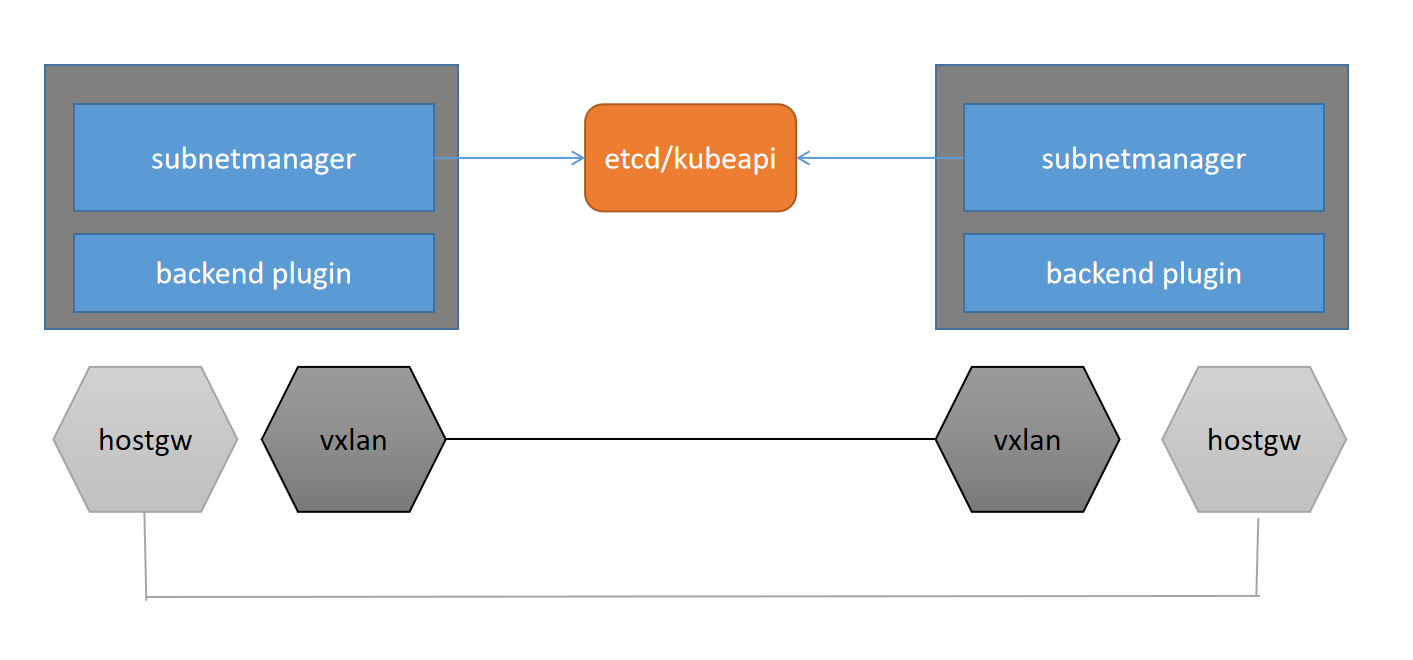Flanneld 源码分析
Flanneld概述
Flanneld进程以daemon运行在每个node节点上,负责该节点的网络(一个子网Subnet)通过节点上的网卡(External Interface)与其它节点node上的网络联通。
Node节点上的子网与其它节点的子网的联通方式有以下几种,每种称为一个Backend。
- HostGW:Node节点处于一个二层网络,直接在二层联通。
- VxLan:Node节点处于一个三层网络,二层不直接相通,那么通过VxLan技术在三层网络上面Overlay一个二层网络,使得各个Host在二层相通。
每个Flanneld管理一个网络(子网)network,这个network借助subnet manager监听集群中各个node的变化,根据node的变化然后借助具体的backend动作实现网络状态的更新。具体的网络动作包括:路由表、ARP表以及FDB表的增加/删除/更新等。
不同的backend实现不太一样。HostGW Backend只需要更新路由表即可;而VxLAN则要同时更新三个表。

基本术语
- Network:一个节点上的Flanneld管理的一个子网就是一个网络。网络通过Backend实现联通性,通过SubnetManager发现node节点的事件,Network根据事件更新网络状态。
- SubnetManager:一个node节点分配一个独立的subnet。SubnetManager监听flannel存储(etcd/kubeapi),发现node的Add/Delete/Update等事件。其实就是通知当前网络:一个新的子网加入/离开了,需要配置合适的规则,将当前网络与目标网络联通/断开。
- Backend:Flannel底层Fabric的实现方式——Vxlan/HostGW等。
- ExternalInterface:node节点上的Iface,提供物理链路。
主流程
这里说的主流程就是main方法中的调用流程,包括一下几个大步骤:
- 首先找出Node节点上的
ExternalInterface。 - 构建针对该Node节点的
SubnetManager。 - 构建
BackendManager,BackendManager中包含以上两个属性。 - 根据配置文件中的
BackendType,比如vxlan,构建对应的Backend。 - 由
Backend生成一个network。 -
网络运行daemon:处理SubnetManager监测到的事件,更新网络状态。 ```go …
// Work out which interface to use var extIface *backend.ExternalInterface …
sm, err := newSubnetManager()
… config, err := getConfig(ctx, sm) bm := backend.NewManager(ctx, sm, extIface) be, err := bm.GetBackend(config.BackendType) bn, err := be.RegisterNetwork(ctx, wg, config) …
go func() {
bn.Run(ctx)
wg.Done()
}()
…
可以看出Flanneld的作用其实是构建了各个Node的网络(Subnet)之间的联通性。至于Node上各个Pod如何连接到Node子网上,则是CNI Plugin——flannel(这个plugin的名字也叫flannel)的作用范围。
## Network的run流程
### run框架流程
1. 构建一个Event的buffered chan——events。
2. 以一个独立goroutine调用SubnetManager的WatchLeases方法,将SubnetManager发现(watch)的event注入到events channel。
3. 当前goroutine陷入循环,处理events channel中的事件。
大致流程代码如下:
```go
func (nw *network) Run(ctx context.Context) {
...
events := make(chan []subnet.Event)
go func() {
subnet.WatchLeases(ctx, nw.subnetMgr, nw.SubnetLease, events)
}()
for {
select {
case evtBatch := <-events:
nw.handleSubnetEvents(evtBatch)
case <-ctx.Done():
return
}
}
}
网络如何处理events事件呢?不同Backend的Network的nw.handleSubnetEvents(evtBatch)方法不一样。
SubnetManager Watch流程
Watch流程
上一节看到,Network的run流程中,通过一个独立goroutine调用subnet.WatchLeases(ctx, nw.subnetMgr, nw.SubnetLease, events)方法,获取subnetmanager中的events。
那具体是如何实现的呢?通过代码可以发现这是通过调用具体的subnetmanager的WatchLeases方法实现的。
func WatchLeases(ctx context.Context, sm Manager, ownLease *Lease, receiver chan []Event) {
lw := &leaseWatcher{
ownLease: ownLease,
}
var cursor interface{}
for {
res, err := sm.WatchLeases(ctx, cursor)
if err != nil {
if err == context.Canceled || err == context.DeadlineExceeded {
return
}
log.Errorf("Watch subnets: %v", err)
time.Sleep(time.Second)
continue
}
cursor = res.Cursor
var batch []Event
if len(res.Events) > 0 {
batch = lw.update(res.Events)
} else {
batch = lw.reset(res.Snapshot)
}
if len(batch) > 0 {
receiver <- batch
}
}
}
而SubnetManager的WatchLeases方法会将当前events chan中一个event封装为LeaseWatchResult返回给外界,以kubeSubnetManager为例:
func (ksm *kubeSubnetManager) WatchLeases(ctx context.Context, cursor interface{}) (subnet.LeaseWatchResult, error) {
select {
case event := <-ksm.events:
return subnet.LeaseWatchResult{
Events: []subnet.Event{event},
}, nil
case <-ctx.Done():
return subnet.LeaseWatchResult{}, nil
}
}
kubSubnetManager结构体中包含一个Event类型的chan——events。
type kubeSubnetManager struct {
annotations annotations
client clientset.Interface
nodeName string
nodeStore listers.NodeLister
nodeController cache.Controller
subnetConf *subnet.Config
events chan subnet.Event
}
那接下来的问题是events这个chan的事件哪里来的?答案是通过Kubernetes client-go的ListWatch机制检测发现,然后加入到chan中的。
Kube API的ListWatch机制
KubeSubnetManager本质上是一个对Kubeapi object Node的一个ListWatch控制器。KubeSubnetManager的run方法启动该控制器。
根据监控到的Node节点的状态变化,分别执行如下3个方法:
- AddFunc:ksm.handleAddLeaseEvent(subnet.EventAdded, obj)
- UpdateFunc:ksm.handleUpdateLeaseEvent
- DeleteFunc:ksm.handleAddLeaseEvent(subnet.EventRemoved, obj)
通过代码可以发现,这三个方法最终都会把一个Event事件放入subnetmanager的events chan中,这个chan的大小目前设置为5000。
indexer, controller := cache.NewIndexerInformer(
&cache.ListWatch{
ListFunc: func(options metav1.ListOptions) (runtime.Object, error) {
return ksm.client.CoreV1().Nodes().List(options)
},
WatchFunc: func(options metav1.ListOptions) (watch.Interface, error) {
return ksm.client.CoreV1().Nodes().Watch(options)
},
},
&v1.Node{},
resyncPeriod,
cache.ResourceEventHandlerFuncs{
AddFunc: func(obj interface{}) {
ksm.handleAddLeaseEvent(subnet.EventAdded, obj)
},
UpdateFunc: ksm.handleUpdateLeaseEvent,
DeleteFunc: func(obj interface{}) {
node, isNode := obj.(*v1.Node)
// We can get DeletedFinalStateUnknown instead of *api.Node here and we need to handle that correctly.
if !isNode {
deletedState, ok := obj.(cache.DeletedFinalStateUnknown)
if !ok {
glog.Infof("Error received unexpected object: %v", obj)
return
}
node, ok = deletedState.Obj.(*v1.Node)
if !ok {
glog.Infof("Error deletedFinalStateUnknown contained non-Node object: %v", deletedState.Obj)
return
}
obj = node
}
ksm.handleAddLeaseEvent(subnet.EventRemoved, obj)
},
},
Flanneld流程总结
- kubeSubnetManager通过ListWatch机制检测Node的事,保存到kubeSubnetManager的events chan中。
- kubeSubnetManager提供WatchLeases方法,将events chan中的一个event作为LeaseWatchResult返回给外界。
- Network调用WatchLeases,循环调用subnetManager的WatchLeases方法,采集event事件,注入到方法提供的receiver chan中。
- Network中根据receiver chan中的事件进行处理,不同Backend的Network实现方式不一样的。HostGW Backend只需要更新路由表;而VxLAN则要同时更新ARP表、FDB表和路由表。
SubnetFile
Flanneld默认将把Subnet信息写入到SubnetFile中/run/flannel/subnet.env。
内容大概如下:
FLANNEL_NETWORK=192.169.0.0/16
FLANNEL_SUBNET=192.169.1.1/24
FLANNEL_MTU=1450
FLANNEL_IPMASQ=false
Flannel的CNI插件将使用到该文件。